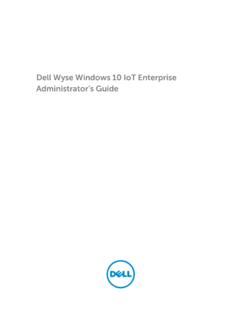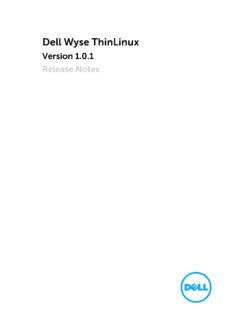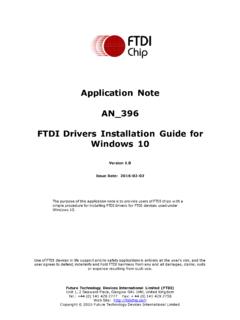Transcription of Dell Wyse Windows 10 IoT Enterprise for Wyse …
1 Dell wyse Windows 10 IoT Enterprise for wyse 5060. thin client Administration's Guide Notes, cautions, and warnings NOTE: A NOTE indicates important information that helps you make better use of your product. CAUTION: A CAUTION indicates either potential damage to hardware or loss of data and tells you how to avoid the problem. WARNING: A WARNING indicates a potential for property damage, personal injury, or death. Copyright 2017 Dell Inc. or its subsidiaries. All rights reserved. Dell, EMC, and other trademarks are trademarks of Dell Inc. or its subsidiaries. Other trademarks may be trademarks of their respective owners. 2017 - 01. Rev. A00. Contents 1 6. Dell wyse technical Dell wyse online 6. 2 Getting 7. Logging 7. Automatic and Manual Using Your 8. Using the Start 8. Using the Search 9. Using Action 9. Grouping Applications into 10.
2 Before Configuring your Thin Working with Unified Write Filter 10. Brief Introduction about NetXClean 11. Connecting to a Printer or an External 11. Connecting to 11. Power 3 Notable 12. Browsing the internet with Internet Explorer 12. Using the Dell Thin Client 13. Configuring Citrix Receiver session 14. Configuring the Remote Desktop Connection session Using VMware Horizon Client to connect to a virtual 16. Configuring a vWorkspace Configuring vWorkspace 17. Using Ericom Connect-WebConnect Using Ericom PowerTerm Terminal CAD 19. wyse Device Agent (WDA).. 20. Citrix HDX RealTime media 20. Microsoft Lync VDI 2013 plug-in ..20. Adobe flash 20. Windows media Windows defender Advanced Threat Protection (ATP)..20. 4 Admin specific 22. Using Administrative Configuring component 22. Managing the Using TPM and 3. Configuring Bluetooth Configuring Wireless Local Area Network 24.
3 Using Custom Configuring the RAMDisk 25. Enabling auto 26. System Viewing and configuring SCCM System Center Configuration Manager (SCCM) client LTSB 27. Devices and Adding 27. Adding Configuring Dual Monitor Managing audio and audio 28. Using the sound dialog Using the Realtek HD audio 29. Setting Managing User 29. Using Windows 30. 5 Additional Administrator Utility and Settings Automatically Launched 31. Utilities affected by log off, restart, and shut 31. Unified Write Filter (UWF)..32. Running Unified Write Filter Command Line Enabling and Disabling the Write Filter Using the Desktop Setting the Write Filter 34. Understanding the NetXClean Saving Files and Using Local 36. Mapping network 37. Participating in 37. Using the Net and Tracert Managing Users and Groups with User Creating User 39. Editing User Configuring User Changing the computer name of a thin 6 System 41.
4 Accessing thin client BIOS 41. Restoring BIOS default 41. Unified Extensible Firmware Interface (UEFI) and Secure Booting from a DOS USB Key .. 42. Booting from a UEFI USB 42. Creating a Boot disk UEFI USB Key ..42. WDM Software for Remote 42. Configuring and using 4. TightVNC (server and viewer)..43. TightVNC (server and viewer) Using TightVNC to shadow a thin client .. 44. Configuring TightVNC server properties on the thin client .. 44. 7 Establishing a Server 45. Understanding how to configure your Network 45. Using Dynamic Host Configuration Protocol (DHCP).. 45. DHCP Using Domain Name System (DNS) .. 47. About Citrix 47. About VMware Horizon View 5. 1. Introduction Dell wyse thin client devices running Microsoft Windows 10 IoT Enterprise provide access to applications, files and network resources. It is made available on machines hosting Citrix Receiver, Microsoft Remote Desktop Connection, VMware Horizon client session and Dell wyse vWorkspace services.
5 Other locally installed software permits remote administration of the thin clients and provides local maintenance functions. More add-ons are available that support a wide range of specialty peripherals and features for environments needing a secure Windows user interface with 64 bit Windows compatibility. Your thin client device supports Microsoft Silverlight and dot NET Framework or later versions. For more information, see Session and networks services available and accessed on Enterprise networks, a direct intranet connection or from a remote location using a secure gateway from Citrix, Microsoft, VMware or Dell wyse vWorkspace. Dell wyse technical support To access technical resources self-service portal, knowledge base, software downloads, registration, warranty extensions/ RMAs, reference manuals, and so on, visit . For Customer Support, visit contents/us/en/19/article/Contact-Inform ation/International-Support-Services/int ernational-contact-center?
6 Ref=contactus , and phone numbers for Basic and Pro Support are available at . NOTE: Before proceeding, verify if your product has a Dell service tag. For Dell service tagged products, go to Dell wyse online community Dell wyse maintains an online community where users of our products can seek and exchange information about user forums. Visit the Dell wyse online community forums at: 6. 2. Getting Started This section describes the activities that you can perform to start using your thin client device. You can also find information related to the available desktop features. When you boot your thin client device for the first time, the user desktop is displayed by default. You can log in to the thin client device as a user or an administrator. Administrator can configure a user account to log on automatically or manually by entering the login credentials.
7 To get started using your thin client device, see: Automatic and Manual Logon. Before configuring your thin clients. Using your desktop. Using the Start Menu. Using the Search Box. Using Action Center. Grouping applications into desktops. Connecting to a printer or an external device. Connecting to a monitor. Power state Logging On Whatever we view during the turn on or during the reboot of thin client device depends on the administrators configuration. After creating user account, an administrator can configure a user account to log on automatically or require manual logon with user credentials. For more information, see Managing Users and Groups with User Accounts NOTE: Be sure to disable the Unified Write Filter (UWF) before you change a password on the thin client, and then enable the UWF after your change. For more information, see Before configuring your thin clients.
8 To change the password, hold CTRL+ALT+DEL key combination, and then click Change a password. However, this feature is not applicable for User accounts. Automatic and Manual logon When the user starts the thin client, the user will automatically log on to the user desktop by default. Important: The Windows icon on the taskbar is the start menu button. To log on as a different user or administrator: 1. Click Start Menu User icon Sign Out to log off the current desktop. 2. Click anywhere on the lock screen to view the logon window. 7. 3. You can view the user accounts list on the left-lower corner of your screen. Click the preferred user account and then enter the logon credentials. Administrators The default username is Admin and default case-sensitive Password is DellCCCvdi. Users The default username is User and default case-sensitive Password is DellCCCvdi.
9 Customized User Log in to your thin client by entering the user credentials which you have set for the customized user account. If automatic logon is not enabled, the logon window displays when you boot the thin client device. You can log in using the options mentioned in step 2 and step 3. Using Your Desktop Based on admin configurations, you are able to view the thin client desktop after logging on. The Thin Client Admin Desktop typically consists of the following: Admin Taskbar It includes, The Start Menu button The Search box Quick Launch Bar icons Task View Notification area in the extreme right of the taskbar NOTE: On the extreme right of the task bar, click the New notifications icon to open the Action Center window. For more information about the Action Center, see Using Action Center. Standard Desktop Icons It includes Citrix Receiver Dell Thin Client Application Ericom Connect WebConnect Client Internet Explorer PowerTerm Terminal Emulation Remote Desktop Connection VMware Horizon Client vWorkspace Dell wyse WF Disable Dell wyse WF Enable In addition to the Standard Desktop Icons, an extended set of resources for configuring user preference settings and system administration is included in the administrator Control Panel.
10 To open Control Panel, click Start Menu Control Panel. For more information, see Admin Specific Features. Using the Start Menu The Start Menu helps you to access all programs, folders and settings on your thin client. It contains a list of applications that are installed on your thin client. To open the Start Menu: 1. Log in as an Admin. 2. Click the Start Menu button in the lower-left corner of the screen. 8. NOTE: You can also open the Start menu by pressing the Windows logo key on your keyboard. 3. From the Start Menu, you can use the following options to navigate through the available applications or configure the settings: Settings Use this option to open the Settings window and configure some common Windows settings. The available settings are: System To configure the Display, Notifications, apps and power settings. Devices To configure the bluetooth, printer, camera, and other peripheral settings.







